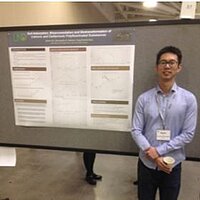Poly- and perfluoroalkyl substances (PFASs) in surface runoff and soil and their fate and effects

Bosen Jin is a Master of Science student in Environmental Engineering program at University of North Dakota. He holds a Bachler of Science degree in Environmental Science from Wuhan University, China. Bosen Jin is currently working on one group of emerging contaminants: poly- and perfluoroalkyl substances (PFASs). His research focuses on the monitoring of PFASs in surface runoff and soil, and the adsorption, bioaccumulation and bioconversion of PFASs.
Email: bosen.jin@und.edu
Phone: (218)791-2679
Fellow: Bosen Jin
Advisor: Dr. Feng Xiao, Department of Civil Engineering, University of North Dakota.Bosen Jin
Degree Progress: Master of Science in Environmental Engineering, expected graduation in Summer 2018.
Poly- and perfluoroalkyl substances (PFASs) in surface runoff and soil and their fate and effects
Per- and polyfluoroalkyl substances (per- and poly-PFASs) are emerging organic contaminants that are toxic, persistent, and present ubiquitously in the environment. Per-PFASs such as perfluorooctane sulfonate (PFOS) and perfluorooctanoic acid (PFOA) have been measured in fish, birds, mammals, drinking water, municipal wastewater, surface runoff, and human blood samples at numerous sites in the United States. Very recently numerous emerging poly-PFASs have been identified in the environment, and some of them are potential PFOS and PFOA precursor compounds. The goal of the project is to investigate the fate and transport of per- and poly-PFASs in surface runoff and the bioconversion of poly-PFASs in earthworms.
Project Objectives:
The specific objectives of this project are to
- Determine the magnitude of PFAS loadings from urban stormwater to the Red River.
- Identify land-use characteristics that lead to PFAS contamination.
- Study the bioconversion of poly-PFASs in earthworms.
Progress:
Water samples were collected, extracted by a solid-phase extraction (SPE) method with XAD-7 resin, eluted with Optima methanol, concentrated to ~0.5 mL, and filtered using a 0.2 µm nylon filter to HPLC vials. Concentrations of PFASs in the samples were determined by a Waters Aquity UPLC system coupled with a Waters time-of-flight mass spectrometer (UPLC–ToF-MS). Furthermore, experiments are on-going to study the bioconversion of potential PFOS and PFOA precursor compounds in earthworms. Standards of four poly-PFASs were custom-synthesized and purchased with faculty advisor’s external grants. Earthworm update (up to 21 days) and elimination (up to additional 21 days) experiments were performed in glass beakers with soils spiked with each of the chemicals to a known concentration. To analyze the concentrations of poly-PFASs, PFOS, and PFOA in worms, the earthworms were crushed in liquid nitrogen and the pieces were homogenized in Optima methanol.
Significance:
The control of organic contaminants like PFASs is a high priority in water resources management of the Red River of the North that is the drinking-water source for Grand Forks, Fargo, and many other cities in North Dakota and Minnesota. The results of this study will 1) contribute to previously very limited knowledge of the level and fate of a major group of emerging contaminants in the Red River Basin; and 2) provide insights for strengthening stormwater BMPs to remove PFASs from runoff and enhancing drinking-water treatment processes against PFASs. Furthermore, our results have shown that all the four poly-PFASs bioaccumulate in worms, and importantly they convert to PFOS and PFOA. It appears that we are the first group who has found the bioconversion of poly-PFASs.
Conference/Seminar Presentations:
Ryan, H., Bosen, J., and Xiao, F. Removal and transport of poly-fluoroalkyl substances. AEESP Distinguished Lecture Series Seminar, March 31, 2017, Minneapolis, MN.
Bosen, J., Bedane, A., and Xiao, F. Bioconversion of poly-fluoroalkyl substances in earthworms. Society of Environmental Toxicology and Chemistry (SETAC) North America Annual Meeting, November 12-16, Minneapolis, MN.
Bosen, J., Bedane, A., and Xiao, F. Generation of PFOS and PFOA from cationic and zwitterionic precursor compounds in earthworms. Manuscript in preparation.

Feng "Frank" Xiao
Civil Engineering
Office: Upson II Room 260K
243 Centennial Drive Stop 8115
Grand Forks, ND 58202-8115
Telephone: 701-777-5150
Email: feng.xiao@UND.edu


